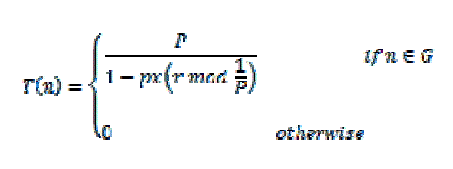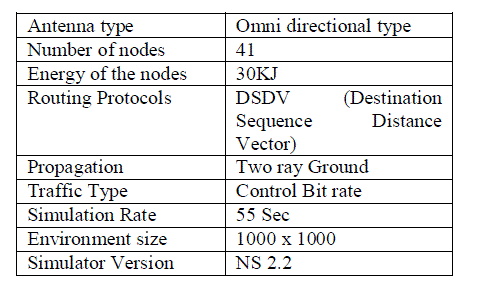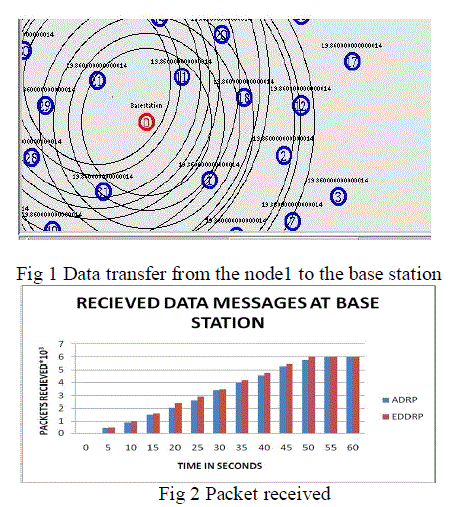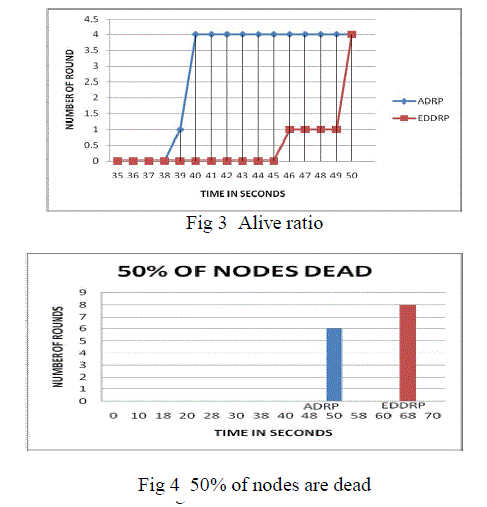Wireless sensor network is deployed with sensor nodes which are spatially distributed across a large area of interest to measure and gather information and transmit the data to the user. The nodes communicate with each other; they cooperate by forwarding data packets to other nodes in the network. One critical issue in the wireless sensor network is how to gather information in an efficient way. Clustering is a technique used to reduce the energy consumption in the network. Here we try to implement multiple hop communication and the consideration of duty cycle to reach the base station and the sensor nodes which are placed near the base station have a higher load of relaying packets. The result shows that EDDRP (Energy distance and duty cycle based Reclustering protocol) gives a longer lifetime to the nodes which enhances more data messages transmission than the other protocols.
Keywords |
| Reclustering, Energy distribution and
distance |
INTRODUCTION |
| A wireless sensor network is composed of a large
number of sensor nodes and a base station.. The nodes
are usually developed randomly inside the region of
interest. [2] The base station is engaged to give
commands to all the sensor nodes to gather information
from the sensor nodes.[2] A sensor node is a tiny device
that includes three basic components such as sensing
subsystem for processing and a storage and wireless communication subsystem for data transmission.
Wireless sensor nodes have many limitations including
processing power,minimum storage and limited power
source. |
| The applications of sensor networks are environmental
monitoring, industrial sensing, diagnostics &
infrastructure protection.
Our methodology to study EDDRP based Protocol which
uses the multi hop communication when the data are
transmitted from the node via the cluster head to the base
station. There are many protocols for communication
within the nodes of the sensor networks. Some of the
protocols are LEACH, LEACH-C, TEEN, PEGASIS
& APTEEN. |
| The implementation of the EDDRP gives an efficiency
much better with total of low nodes death during
communication in the entire network. When the data are
transmitted from one node to another, the sensor nodes
periodically switches on their sensors and transmitter. It
senses the data from the environment and transmits the
data to the base station via the cluster head. In this work
the wireless sensor network consists of 41 sensor nodes
which are deployed randomly in the sensing field.
Clustering means grouping the entire network into
clusters and to communicate within the member node via
the cluster head. [4] The base station split the network
into clusters and elects some sensor nodes as cluster
heads and that particular node will have duty cycle as 1
and will be at full power node which means that the head
node is always on. The nodes are responsible to find the
fresh path to the destination via the cluster head. The main objectives of EDDRP are to increase the lifetime of
the network and allow local coordination between the
nodes and to maximize the energy conservation
efficiency within the nodes. |
RELATED WORK |
| Studies about the energy minimizations and maximum
data transfer are considered depending upon the various
protocols that are implemented in the wireless sensor
networks. |
| In LEACH [1] initially the clusters are created, and each
and every node calculate the energy to become the
cluster head for that particular round. This can be
calculated by comparing present energy status of the
node to the threshold value. T[n] is given by |
 |
| Where p is the pre determined percentage of the cluster
heads, r is the current round and g is the set of round that
have not been cluster-heads in the last 1/p rounds. The
non cluster-head nodes have to be on as it receives the
advertisement message from the cluster-head. The nodes
select their cluster-head depending upon the signal
strength. The cluster head collects the each node during
particular interval of time and sends to the base station. |
| The operation of ADRP (Adaptive De centralized
Reclustering Protocol)[2] is divided into rounds and they
are divided into two phases: initial phase and cycle
phase. In initial phase each node sends the energy &
location details to the base station. The base station splits
them into clusters and depending upon the threshold of
each cluster the member node and cluster head are
selected. |
 |
| Where m is number of sensor nodes in cluster j Ei(t) is the current energy of node i. The energy in each
and every node is anticipated with the threshold energy
and the next cluster head is decided. The node with
higher energy will be next head and the present head will
be declared as the member node. |
| An advertisement message is sent to all the nodes which
have the ID (Identification Number) of the cluster head.
In the cycle phase the cluster head specifies the time
slots allocated for each member to transmit the data.
The head node collects the data from the ember node and
they aggregate the data before sending to the base
station. The next cluster head is selected and the nodes
join to the cluster head and the previous cluster head
switches as a member node and joins the next head. |
| The Heed protocol [6] which describes about the node
residual energy elects as the cluster head. Each and
every node execute constant iteration If two nodes have
the same energy then the distance and node degree are
taken into consideration from their neighbour nodes. |
SYSTEM MODELLING |
| The wireless sensor network is deployed with nodes in
the sensing field and the base station will split the entire
network into cluster and elects the sensor nodes as
cluster heads. The data are collected from all the nodes
in the cluster and they are sent to the base station. When
the nodes transmit the data the energy in that particular
node is decreased. The base station that is located in the
sensing field which is associated with the sensor nodes
for the reception and transmission of the data are usually
assigned with a unique identification number. The nodes
are fixed and they are usually assigned with the location
aware and are monitored by the cluster head. The energy
has to be less consumed and the data has to be
transmitted with more efficiency. This can be obtained
by keeping the nodes in half power mode which will
reduce the energy consumption of the nodes. During
each and every mode of transmission the nodes will be
switched on & off depending upon the need of the
transmission of the packets from the source node to the
destination node. The base station will compute the
average energy in each cluster, and the sensor node that
has less energy than the average energy cannot be the
next head for that particular iteration. |
| Here we implement a protocol which is called Energy
distance and duty cycle based protocol which may be used in the Wireless Sensor Network. The Energy has to
be minimized and the network lifetime has to be
increased. All the data are obtained from the sensor
nodes and are transmitted to the base station and the
entire network is divided into two major areas as cluster
members and re clustering procedure. The member
nodes send the energy status of the nodes to the base
station and they are elected with the cluster heads. The
identification number of the cluster head is transmitted
to all the member nodes. The member with unique
identification number is taken as members of that
particular cluster within the cluster head. In the
transmission stage the data are gathered and aggregated
and they are sent to the respective cluster head. The
cluster head check the data and then forwards the data to
the base station. The data are being received and
transmitted which in turn make the energy of the cluster
head to be reduced. This is reduced as the cluster head is
fully in on mode and as the duty cycle is 1 to be the
cluster head. |
 |
| [4] Here the next cluster head is taken as NHj where the
duty cycle is 1 and Tj is described as the threshold
energy. Hence the current energy has to be greater than
or equal to the threshold energy of the cluster. The data
are sensed by the nodes from the sensing field given to
the cluster head which may in turn the messages are sent
to the base station. Once the data are collected from the
sensing field the nodes are allotted with specific time
slot to declare their packets to the cluster head. The
energy consumption and distribution among the nodes
are periodically taken into consideration for the next
cluster head which in turn create a re clustering with new
cluster heads and member nodes. |
SYSTEM IMPLEMENTATION |
| 1. Deploy 41 nodes in a square area of 1000X1000m |
| 2. Identify each nodes with numbers and their location |
| 3. Initially all nodes have equal initial energy. |
4. Each node is capable of working in different power
modes (like low power listening, medium power
transmission & receiving when they are ordinary
node where as in high power mode when the node acts as a cluster head. Each node is capable of
working with 2 different duty cycles  |
| 5. The cluster head should have duty cycle as 1 it
means that particular node has to be ON |
| 6. After deployment the base station should run an
initial clustering algorithm to mark different clusters
based on their positional information, during which
all nodes are in D=1 and at low power listening
mode. |
| 7. Base station selects a cluster head in each cluster.
Cluster head broadcast packets to inform about its
presence to other nodes whichever nodes listen &
replies they will be nodes within the range of the
cluster head. |
| 8. Once the members of a cluster are identified with
them to the designated duty cycle and also to the
medium power mode. |
| 9. The transmission and the reception of the packets
from any nodes with maximum 2 hops distance
from the cluster head. |
| 10. The residual energy lost in each and every node and
the cluster head is calculated as (initial available
energy – energy lost) in each and every node. |
| 11. Calculate the average energy lost in each and every
clusters and if average energy lost is greater than the
threshold energy then the next cluster head is
selected. |
SIMULATION RESULT |
| The entire network is simulated using NS2 which
provide the simulation of the event that is executed by
providing the requirement of the event. It is a Back end
C++ Event scheduler which in turn creates the protocols
and interface to bring control over the network. This can
be used to create the scenario and to change the tool
command language |
| The topology construction is |
 |
| In our work, we have use the nodes that transfer the data
from the nodes to the cluster head by the DSDV
protocol. They are being implemented by generating a
small size network that has 41 nodes and they create a
UDP(User Datagram Protocol) connection between the
nodes and attach CBR(Constant Bit Rate) which will
generate a constant bit packet throughout the entire
network. The duration of the scenario is 55seconds and
512 byte long. The duration of the scenario is 55 sec and
CBR connection started after a delay of 1 second and
every node and continues till the simulation time
mentioned. |
 |
| Once the data are sent to the base station the packet loss
is evaluated. The number of packets from the sending
nodes and how many are received by the receiving nodes
are calculated. The number of packet loss is compared to
that ADRP and found that the packets received is better
in EDDRP when the nodes are been kept in half power
mode on To evaluate the number of packets transmitted
which in turn give the efficiency of the nodes. Here the
nodes that transmit the data will lose the energy and the
number of death node is less when they are executed
with the half power mode and it is compared with the
other protocols. |
 |
| The fig 3 shows the nodes that are alive for the number
of iterations. When the alive ratio is compared with
ADRP the first nodes die in 39sec as it is kept full time
ON. The EDDRP protocol in the first node dies in 46sec.
Hence the EDDRP protocol performs much better than
ADRP. Fig 4 shows the network life time which is
defined by finding out the number of dead nodes. |
CONCLUSION |
| The Simulation scenario which is implemented with 41
nodes that has constant energy of 30KJ and that uses DSDV protocol and also the same is simulated by
introducing the half power mode. This shows the number
of packet lost and the death rate of the node is less when
compared to other protocols. The EDDRP which has an
enhanced performance than ADRP over the life time of
the nodes in the network. The death ratio of the nodes
are less when they are compared with ADRP The
transmission is kept in control with the EDDRP protocol
as the required node is kept ON which will minimize the
unnecessary packet transmissions, which will save the
power that reduces the packet loss and which in turn
provide the increase in the network performance than
ADRP |
References |
- Wendi RabinerHeinzelman, AnanthaChandrakasan, and HariBalakrishnan Energy Efficient Communication Protocol for Wireless Micro sensor Networks inproceeding of the 33rd Hawaii International conference on system science vol 2,2000.
- FaudBajaber ,IrfanAwan: Adaptive decentralized re âÃâ¬ÃâClustering protocol for Wireless sensor networks. Journalof Computer and system Sciences. 77(2011), Page 282 âÃâ¬Ãâ292
- ArthiManjeshwar and Dharma P Agrawal âÃâ¬ÃÅTEEN: ARouting Protocol for Enhanced Efficiency in Wirelesssensor networksâÃâ¬Ã in parallel and Distributed processingsymposium proceeding 15th International conference 23 âÃâ¬Ãâ27 April 2000 pages 2009 âÃâ¬Ãâ 2015.
- Ian.F.Akylidis, WeiliamSu, YogeshSankarasubramaniam, and ErdalCayirici A Survey on Sensor Networks Georgia Institute of Technology ,IEEECommunication Mag 40 (8) (2002), 102 âÃâ¬Ãâ 104
- Jamal N. Al âÃâ¬ÃâKaraki Ahmed E.Kamal, âÃâ¬ÃÅRoutingTechniques in Wireless Sensor networks: A SurveyâÃâ¬ÃÅIFEE Communication Society. IEEE Volume 11, issue6dec 2004, page 6 âÃâ¬Ãâ 28.
- OssamaYounis and Sonia Fahmy , âÃâ¬ÃÅDistributedClustering in Ad-hoc Sensor Networks: A Hybrid,Energy-Efficient ApproachâÃâ¬ÃÂ, IEEE mobile computer 23(4) (2004), Page 366 âÃâ¬Ãâ 379.
|